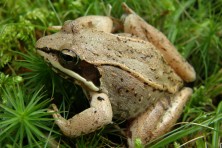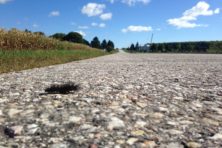The Northern Leopard Frog
- Share
- Tweet
- Pin
- Share
There is an amphibian in Door County, the Northern Leopard Frog, which has been of special interest to me for the past 45 years. All too often one hears or reads about the steady decline of certain native plants or animals but, with very limited access or exposure to these species, it’s difficult to display even the slightest concern over the problems.
My work in Door County at the Ridges Sanctuary, much of it outdoors, began in the summer of 1964. I observed what I thought were normal Leopard Frog populations for the following seven or eight years. Late August during each of those years found the margins of the wet swales between the ridges so abundant with these spotted frogs that one almost had to be careful to not step on them, or so it appeared. There were many hundreds of these amphibians remaining close to the water in which they would have to spend the winter.
How drastically the picture had changed by the summer of 1975. Prior to that year Green Frogs by the dozens strummed their “loose-stringed banjos” in the swampy northern reaches of the Mud Lake Wildlife Area north of Baileys Harbor. Now we hear none, and we have heard none since then, approaching 35 years. Leopard Frogs too had vanished by the mid 1970s as though by magic. Reports began to surface from throughout the U.S. and Canada. Reductions in their populations were astounding, 50 percent, 90 percent, and in some previously high-count areas not one Northern Leopard Frog could be located.
Up to about 1963 a leading biological supply house in the Midwest had been shipping in excess of 30 tons of Leopard Frogs annually to high schools, colleges and scientific laboratories. Many tons were caught and sold from, for example, the Oshkosh area with its vast wetlands. Today that creature is rarely used for experimentation.
Possible reasons for the frightening disappearance and reduction of so many species of frogs and toads worldwide have included loss of habitat, fragmentation of habitat, over-exploitation by people, spread of competing exotic species, human interference such as pollution, climate change, and the increase of UV-B radiation due to atmospheric ozone depletion, thereby weakening the amphibians’ immune systems.
In recent years Leopard Frogs caught at the Sensiba Marsh across the bay and north of the UW-Green Bay campus were shipped overnight to a U. of California at Berkeley lab for testing and found to have traces of Atrazine in their bodies. Atrazine is considered to be the most commonly used herbicide in the U.S. Contamination, in excess of 1.0 parts per billion, is found even in precipitation and in areas where it is not used. This chemical has been found to be hard on Leopard Frogs. Amphibians’ water-permeable skin makes them extremely vulnerable to water pollution. Leopard Frogs are extraordinarily sensitive because they spend the entire winter submerged in water below the ice.
A 1994 study determined that Leopard Frogs were observed in only 15 (5 percent) of 301 suitable breeding sites in Wisconsin. One fact that must be considered is that their decline can emphasize environmental problems with wide implications for other organisms besides amphibians. One biologist summed up the situation simply, stating that the frogs are disappearing due to humans’ insensitivity to the earth’s environment.
In August of 1999 I went hiking with Charlotte and some friends at Toft Point, and I nearly danced with joy when we discovered a large, healthy-looking Leopard Frog, one of the biggest I’ve ever seen.
Rather than the usual green color, this one was very bronzy and some of its irregular dark spots were faintly rimmed with green. What a gorgeous frog! Upon attempting to approach it for photographs it soon displayed its leaping ability – five or more feet!
Ever so gradually over the past ten years several other people, especially on the Lake Michigan side of northern Door County (friends living along the shore of Kinsey Bay, for example), have reported seeing a few Leopard Frogs. Our involvement with the eradication of the invasive Phragmites at the Toft Point State Natural Area during the past three summers has kept us in close contact with the wetlands there. Several dozen Leopard Frogs have been seen each summer during our work.
In August of 2008, my friend Nick Anderson and I witnessed one of the largest Leopard Frogs either of us had ever seen, a genuine “Alpha” of the species of unknown sex. Fortunately the creature posed to perfection for photographing. Biologists studying these frogs in recent years are finding an increasing number living only into their second year, compared to the more normal life span of three to four years. This well-rounded specimen surely was four or more years old.
It was within the past two weeks that my friend Tom Turriff and I were doing some invasive weed work in the marsh at the west end of Moonlight (Mud) Bay and were overjoyed to see a few dozen Leopard Frogs there too, all rather small with the exception of a very large one which displayed absolutely Herculean jumps, one after another; in its effort to escape our approach. Undoubtedly, with this relatively secluded environment being a part of the summer home of Sandhill Cranes, Great Blue Herons and, more recently, a pair of Great White Egrets, this frog has learned to preserve its very existence by skillfully leaping and hiding in order to remain out of these predatory birds’ way.
The point that scares me, in light of my 45-year interest in the Leopard Frog, is that when a species starts to decline in number it’s usually too late to help them. Often, scientific study amounts to little else but writing an obituary for a species. The Leopard Frog, like the miner’s canary in the cage, should be a trumpeting herald, a high-pitched warning to humans that it’s high time we get shaken out of our passive unconcern over the steady deterioration of the environment, particularly the millions of tons and gallons of biocides (killers of life) this sick planet of ours is pelted with each year.
The word amphibian is from two Greek words, “amphi” and “bios.” Together they mean “living a double life.” If all of us had to live a double life, one as a human, the other as a frog, we’d be screaming to the tops of our lungs for help in cleaning up the environment, and that includes the soil, water and the air.
The Native American, Chief Luther Standing Bear, reached me with his poignant words: “Let’s put our minds together to see what kind of a world we can make for our children.” Every one of us has to improve our stewardship of this amazing planet. Please help all you can!



